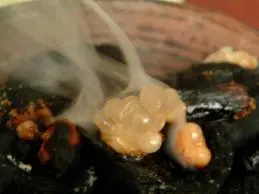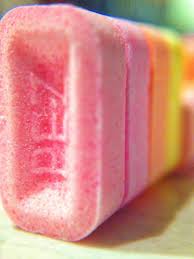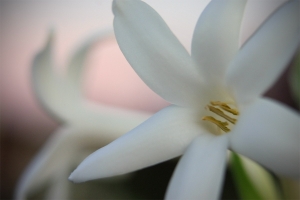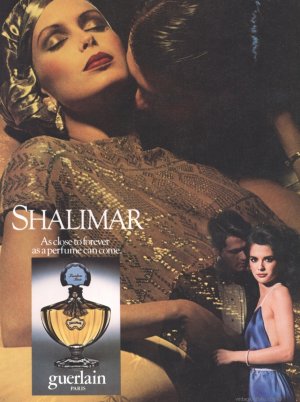Some perfumes have a quiet prettiness that weave their way around you over time, or that touch you with a feeling of comforting familiarity. Sometimes, they are also about a study in contrasts, contradictions that work together seamlessly in a way that becomes more important than the individual notes. Sacrebleu Intense from the Guerlain descendent, Patricia de Nicolaï, and her company, Parfums de Nicolaï, is one of those perfumes.
It is an eau de parfum that appealed to me the first time I smelled it, but it didn’t bowl me over and throw me into a state of maddened lust. It still doesn’t, if truth be told, but Sacrebleu Intense quietly squirreled its way into my thoughts, and I ended up succumbing to a relatively blind buy months after the fact. It has a quiet solidity and classical appeal with just enough of a nod to the past to be comforting at times.
What I like is the feeling of contrasts that have been superbly blended into a seamless whole. There is sticky, chewy darkness, but also, airy, white sweetness. Bitter green leafiness lies side-by-side with boldly fiery, red cloves, brown cinnamon, smoky blacks, and twiggy, petitgrain, neroli orange-browns. Sometimes, the contrasts are just about the stark black and whites: black licorice and smoke, against white Church incense and spicy red carnation. Sometimes, they are about gender, as femininity collides with touches of masculinity. Often, they are about boldness and strength mixed with refined quietness; or the contradictions of weightless heaviness.
Sacrebleu Intense is about all those things. It is fierce and potent, but understated and quietly elegant. It is a nod to the past that is also very modern. It has a simple beauty whose appeal grows stronger with time, and it manages to stay in your head, long after you’ve smelled it. At least, that was the case for me. I first encountered the perfume in Paris where I was trying the full Parfums de Nicolaï‘s line at one of her shops. (From this point out, I hope you will forgive me if I spell Nicolaï as just “Nicolai” for reasons of speed and convenience, as it takes a while to put on the dots, or Trema.)
Sacrebleu Intense stood out immediately amidst the Nicolai offerings. A few of the other scents were pretty, but too subdued or restrained. A good number felt too damn thin by half, but Sacrebleu Intense made me do a wee, tiny double-take, and I sniffed my wrists appreciatively. However, I almost never trust first impressions and needed a sample to test to see how it would develop over time, especially on my wonky skin. Unfortunately, the Parfums de Nicolai line doesn’t seem to believe in that practice, and I was always told, “I’m sorry, we don’t have any vials.” So, I skipped it. Upon my return to America, though, the memory of Sacrebleu Intense nagged away at me for months. I finally said, “to hell with it,” and ordered a bottle.
I did so for one reason, and one reason only. Every time I had tested Sacrebleu Intense, the same thought rang in my head: “L’Heure Bleue. This is a definite nod to L’Heure Bleue, only it’s more modern, fruitier, with different spices, and possibly a more unisex feel.” Now, vintage L’Heure Bleue is one of my two, absolute favorite Guerlain scents. In fact, it is only fickleness and a slightly fiercer love for vintage Shalimar that prevents L’Heure Bleue from ranking as my favorite Guerlain of all. Plus, vintage L’Heure Bleue can be a wee bit powdery for my tastes, though none of it matters in the face of the reformulated modern version. Sacrebleu Intense reminds me of vintage L’Heure Bleu, though with enough differences for it to be its own scent. It feels more modern, and not as wistful in nature.
The strong connection to one of Guerlain’s masterpieces should come as no surprise to anyone who knows about Patricia de Nicolai‘s background. I’ve written about how she is part of the Guerlain family, a grand-daughter of the house’s founder, Pierre Guerlain, a niece to Jean-Jacques Guerlain, and a relative of the famed nose and current Guerlain family patriarch, Jean-Paul Guerlain. Madame de Nicolai is also on record as saying that she absolutely loves L’Heure Bleue, though she stopped just short of saying that it is the Guerlain scent that has had the most impact on her own perfumery. Still, her love of L’Heure Bleue shines through in Sacrebleu Intense, though I have to emphasize that I think they are very different scents at their heart.
Sacrebleu Intense is an eau de parfum that was released in 2008. It seems to have been intended as a bolder version of the original Sacrebleu which has now been discontinued, though I’ve also read in one place that the Intense was meant to highlight the floral notes more than the original. According to Fragrantica and Luckyscent, Sacrebleu Intense has:
Top notes: mandarin orange, red berries and fruity notes; Middle notes: carnation, tuberose, cinnamon and jasmine; Base notes: peru balsam, sandalwood, tonka bean, patchouli, olibanum [myrrh], woody notes and vanilla..
Sacrebleu Intense opens on my skin with massive amounts of carnation cloves, followed by cinnamon, dark resins, and green notes. There is a strong spiciness to the scent beyond just the cloves, a sort of piquancy that makes me think of peppery, fuzzy geranium leaves, as well as of bitter neroli and petitgrain. Petitgrain is a citrus tree’s twigs, distilled down into the bitter, pungent woody, masculine notes, while neroli is a different method of distilling the trees’ orange blossoms. Honestly, on my skin, I don’t smell mandarin oranges in their traditional, sweet, sun-ripened juiciness. There is the strong bitterness of neroli, and the woodiness of petitgrain instead.
 There are other elements as well. Lurking in the base is a black, leathery smokiness from the styrax, the least sweet of all the resins or benzoin-like notes. There is also a heavy presence of olibanum or myrrh. It is nothing like the High Church, soapy, chilly, dusty character that it usually manifests, at least not yet. Instead, it smells like chewy black licorice with a hint of anise. There is a definite sense of smokiness, though. A sweet incense note that feels like sweet myrrh, rather than pure, dry, black frankincense.
There are other elements as well. Lurking in the base is a black, leathery smokiness from the styrax, the least sweet of all the resins or benzoin-like notes. There is also a heavy presence of olibanum or myrrh. It is nothing like the High Church, soapy, chilly, dusty character that it usually manifests, at least not yet. Instead, it smells like chewy black licorice with a hint of anise. There is a definite sense of smokiness, though. A sweet incense note that feels like sweet myrrh, rather than pure, dry, black frankincense.
The odd thing is the nature of the floral notes. I’ve worn Sacrebleu Intense a few times, and only once did I ever really detect tuberose. It was brief, very muted, and had a slightly rubbery, black undertone to it. However, the tuberose was so thoroughly blended into the other elements, it was extremely hard to pick out and I don’t think it lasted for more than perhaps 10 minutes at best. The main flower on my skin instead is always the carnation, though it is barely floral at all. Carnations can take on a peppered rose aroma or a clove-like one, and it is the latter which shows up on my skin. In fact, Sacrebleu Intense is heavy cloves from start almost to finish, with only a touch of actual carnation.
I keep imagining a clove flower with a spicy neroli heart, bitter petitgrain twigs and peppery, pungent, green geranium leaves, all dusted with cinnamon. The “flower” grows out of soil made from black licorice and the stickiest, chewiest, balsamic resin around. It’s a base that is faintly leathered and smoky, but the main impression is of bitter fruits heavily dusted with cinnamon and cloves.
For the most part, Sacrebleu remains that way for the majority of its long life on my skin. This is a fragrance that is beautifully blended, and each time I wear it, different parts seem to be emphasized alongside the clove carnation. Never the tuberose, but the green bits and the smokiness seem to fluctuate in degree. On one occasion, all that came to mind was black, chewy, resinous smokiness on a white, airy background that felt only vaguely fruited and was heavily dusted with spices instead. As a whole, Sacrebleu Intense is a scent that is very hard to pull apart. The notes move into each other seamlessly, and, as indicated, that makes the perfume a bit linear in nature. For that reason, this review will be a little different than most of mine, and will focus mainly on the perfume’s overall development and feel.
The one thing that does change (and is quite constant each time I wear Sacrebleu Intense) is the touch of powderiness that creeps in after a while. When it precisely occurs seems to vary, and I’ve noticed that one arm (my right, which is not my usual testing arm) reflects very little of it as compared to the other, but there is always some degree of powder. At first, it’s only a subtle touch that is almost iris-like at times. It’s definitely sweetened powder, and its combination with the bitter neroli and petitgrain-like accord creates a distinct impression of Pez candy. A sort of Sweet-Tarts or Pez powderiness, if that makes sense.
I have to admit, I’m not very keen on it, and I become less keen as time passes because it turns into quite a distinct myrrh incense note that I always struggle with. It’s a spiced, slightly dusty powderiness, though much more sweetened than most High Church incense fragrances. As regular readers know, I’m not particularly enthused by High Church or Catholic Mass tonalities, let alone powder, so I must admit, I struggle a little with Sacrebleu after about 5 or 6 hours. Still, as noted earlier, the perfume is well-blended and there are enough spicy clove, carnation, and resinous elements to make up for it.
In its final stage, Sacrebleu Intense is a blend of myrrh incense, spiciness, and sweetened Pez powder, lightly flecked with bitterness and a hint of something vaguely fruity. In its last moments, it’s powdered sweetness and myrrh. I like it… from afar and as long as I don’t smell it up close too much.
All in all, Sacrebleu Intense consistently lasts 12 hours or more on my wonky skin, depending on how much I apply. It generally becomes a skin scent about 4-5 hours into its development, though it requires absolutely no effort whatsoever to detect the perfume if you bring your nose near your arm. Furthermore, you can push both time frames if you spray on a lot. With 3 big sprays, I once experienced a 14 hour duration, even though I had to put my nose on my skin and sniff extremely hard to detect the faint traces after the 12th hour.
I’m glad I bought Sacrebleu Intense, though I have mixed feelings about the drydown stage. In fact, if some of my discussion sounds a little like blind buyer’s remorse, there is that on occasion, but only because I really don’t like Churchy myrrh incense or powder. That said, there is something about the opening moments of Sacrebleu Intense that really compensates for it all.
I can’t really explain in any logical way except to say that there is a mood and feeling which overcomes a lot of the sticky details down the road. Something about Sacrebleu Intense feels like elegant familiarity, perhaps because of that distant, tiny kinship to L’Heure Bleue. It’s such a classic, refined scent that it makes me feel as though I should sit up straighter, put on my best clothes, and get ready for a garden party. It feels like something suited for High Tea at the Plaza Athenée, or a walk through the Jardins de Luxembourg near the Louvre. It lacks the va-va-voom luxuriousness of vintage Shalimar, or the emotional power of vintage L’Heure Bleue‘s haunting melancholy, but Sacrebleu Intense has a definite, quiet charm.
Sacrebleu Intense doesn’t take me back in time or feel dated. I don’t feel as though I belonged in the 1920s or 1950s. Perhaps because there is an airiness to the scent that seems to belie the strength and potency of its spicy, piquant notes. It doesn’t feel opulently heavy at all, to the point that I don’t think of luxuriousness when I think of Sacrebleu Intense. Rather, I think of spiciness — intense spiciness and resins. Peppered, resinous, smoky, chewy blackness and white daintiness, speckled with every shade of red, brown and green.
In some ways, Sacrebleu Intense feels a little like an attractive girl whose appeal grows stronger over time. She may not blow you away at first, and, in fact, she may not even sweep you off your feet after you’ve known her for years, either. But you’d definitely miss her if she weren’t around, and, whenever you’re with her, you enjoy the experience. Something about her stays with you — her good humoured spiciness, perhaps — and you can’t forget how comfortable she makes you feel.
Almost all the blog reviews out there are for Sacrebleu, the original, and not for Sacrebleu Intense. There is said to be a difference. It’s not only that Sacrebleu was an eau de toilette, while the Intense is an eau de parfum, but the notes seem to be different. The original is said to have included: black currant bud, peach blossom, jasmine, tuberose, vanilla, tonka bean and incense. I also vaguely remember one Parfums de Nicolai sales lady telling me that the focus of the two scents is different, though for the life of me, I cannot now recall how.
The one blog review for Sacrebleu Intense comes from Nathan Branch who writes:
For a couple of hours, Sacrebleu Intense is mesmerizingly beautiful — rich, full, deep . . . like a roomful of cellists all playing the same sad, sweet song, but then everything starts to sound (or, in this case, smell) a little off — too much noise, too many notes crammed up close together and discordantly overlapping.
It’s a shame, too, because when the stuff is pulling together it really shines, but the last half of the scent’s lifespan is a sloppy mess — well, until you hit the patchouli/balsam drydown, which deserves some praise.
Maybe the original, less pumped-up Sacrebleu is better, less messy, than this Intense version?
On Basenotes, one person has the following thoughts on the two versions:
Sweet but not fruity once the initial orange has departed. Close to, the jasmin is not wholly evident, but floats a nose- distance away until displaced by carnation (not cloves). The cinnamon is a mere hint (according to the assistant in PdN in Paris the ‘intense’ version has vanilla instead of cinnamon, but it’s still there to me). Overall less spicy than sacrebleu and therefore easier to wear. Intense is an edp rather than the original sacrebleu which is an edt. However the difference is not just in the concentration, they smell noticeably different, so worth trying both
As a whole, forum and website reviews for Sacrebleu Intense are mixed, with the vast majority being very positive in nature. I also think the reason for the split is that Sacrebleu Intense is a perfume best suited to those with specific tastes, starting with an appreciation for L’Heure Bleue. After that, ideally, you’d love a heaping amount of cinnamon, myrrh incense, and the bitter petitgrain and neroli aspects of orange. It might also help if you like Pez powder or Smarties, the latter being a comparison that was raised in two Fragrantica reviews.
One Fragrantica commentator, “vitabhaya,” has what I think is a good summation of Sacrebleu Intense:
Call me nuts, but the topnotes on this smell like a blend of Guerlain’s L’Heure Bleue and Smarties–you know, those colored, super-sweet candies that come in a roll. It is melancholy but energizing, sweet yet with a great mellow depth, really a mezmerizing fragrance.
After an hour or two, the tonka bean, patchouli, sandalwood and olibanum lilt along the edge of a vanilla that is neither quite sweet nor spicy. It feels rich, sensual and downright sexy. It reminds me of late afternoon sun drifting through the curtains after a lover’s rendevous. There is something hypnotic about this blend, and I find myself lingering with my arm up to my nose long enough to wonder how long I’ve held this pose. Suddenly I feel as if I enjoy the longing for past lovers for pure memories’ sake. I cannot at this point decide if it is slightly melancholy (L’Heure Bleue?) or if it is rather dusky and languid. Oooooh, how I love it!
This goes on the “must have” list.
Other Fragrantica commentators seem equally enamoured, with one saying that Sacrebleu Intense had replaced L’Heure Bleu in her heart:
- For a very long time, since we first met in a candy-box perfumery in Salzburg decades ago, L’Heure Bleue was my absolute favourite scent of all. With all due respect and nostalgia, the Pefume Queen’s Throne in my heart is now occupied by another sovereigh: Sacrebleu. (Especially that L’Heure Bleue’s new formula does not have the perfection of its predecessor.) It is the softest, most embracing, soothing, calming scent about, and I absolutely enjoy its elegant velvety dark character. Mind you, Sacrebleu’s darkness is not menacing, it’s mistery is not dangerous. It is a peaceful night, when you know you are safe, loved and can relax without a hint of worry and care. It is related to L’Heure Bleue, but more modern, less melancholy and much more life-affirming. [¶] To my nose and mind this scent is so perfect, that while wearing it I never once try to isolate it’s notes…it is a perfect harmony, and I don’t care the least what single notes make up this wonderful olfactory symphony. Truly wonderful!
- I think Sacrebleu Intense is one of the sophisticated and finest scents I have sniffed. Very feminine [….] I do not get candies from Sacre Bleu, but sacred feel yess. I have also L´heure Bleue and this might be kinda sister, but they are standing quite far from each others. Sacrebleu is more sensitive…. but eaven if she is sensitive do not take her to be not strong!
- Prepare yourself to be granted a sweet redemption, to gain a second or third youth, to leave the ground and premises in bliss… [¶] Concentrate on happiness! […][¶] Olibanum and Peru Balsam control the -harsh- tubereuse. Carnation and Tonka Bean rule over the omnipresent cinnamon. Mandarin, Jasmin and Sandal turn your face to the light! [¶] Sacrebleu Intense has lifted me with joy.
- I got this sample from the lovely Carnation. I smell hot spice! This is warm and intense and perfect for me. There is a sweetness to it that could be vanilla but its not cloying. This is a perfect combination of the things I love, Sandalwood, Patchouli, Vanilla and Spice (must be the cinnamon) I love it!
One male commentator loved Sacrebleu as well, writing:
A fruit and floral aroma that embraces you with power, quality and exuberance.
The heart is beautifully made of jasmine and tuberose, going to a soft side of the fragrance, surrounded by peru balm, olibanum (frankincense), woods and a delightful vanilla.
It starts completely feminine and then, goes to a more unisex scent during its evolution on the skin. Fierce yet delicate, strong yet romantic…nice work!
However, not everyone was quite as thrilled, whether from the fruit or the spices. In fact, I think the following comments underscore the importance of a love for cinnamon, not to mention skin chemistry, of course:
- very fruity and sweet. vitabhaya mentions Smarties and L’heure Bleue. I agree about the Smarties, but feel it’s only got a nod in passing from L’Heure Bleue. I purchased a sample because I love cinnamon and hoped for more cinnamon/carnation effect – but fruit tends to overwhelm my nose. Should have checked more carefully, because the top notes are all fruity, and they tend to hang around. Altogether not bad, won’t be one of my favourits, though.
- Sweet,juicy fruity opening,but I could not detect any spices throughout this at all. […] It’s probably one of the worst I have smelled-cloying and rubbery would describe this perfectly.
- I get cinnamon, but the horrid thing is that on my skin it smells like a cheap cinnamon candle. [¶] You ever been to a candle store, and then felt a bit yuck after smelling a tonne of candles? That’s this scent on my skin, unfortunately.
- Hmmm, no. Opening is sweet orange, then comes cinnamon that has a very synthetic feel to me. A whisper of flowers, then some Tonka in the dry down. Average longevity and projection. L’huere bleu made me realize that I have a strong desire to smell like carnations and I was hoping this would be an interesting, well rounded composition with a clear carnation note, but it seems to have been hidden by the cinnamon. So disappointed.
On my skin, as noted, the clove-like smell of the carnations was far more dominant, but Sacrebleu Intense has a few resins or benzoins that can manifest a cinnamon side. Given that the perfume contains actual cinnamon as well, then you bloody well better like the spice if you’re going to try the perfume!
You should also like strong perfumes. On Surrender to Chance, one person commented that they liked the juicy, fruity opening but that Sacrebleu Intense was “too strong.” Well, it is, but that’s why I gravitated towards it, instead of the thinner scents in the line. Sacrebleu Intense is definitely a scent for those who like their fragrances to be bold and full-bodied.
One of the big positives about Sacrebleu Intense, and the Parfums de Nicolai line in general, is affordability. There is always a small 30 ml size which is very reasonably priced. For Sacrebleu Intense, the 1 oz size costs $65 or €51. It may be too tiny for some, but it’s great if you have a vast number of scents in your collection, or if you just don’t want to spend a fortune on perfume. Plus, as noted earlier, a little Sacrebleu Intense goes a long, long way.
Lastly, I think Sacrebleu Intense skews a little feminine, but not overly so and really only at the start. The incense, resins, spices and piquant neroli certainly make it very unisex in nature. My only hesitancy is the slight powderiness of the scent. It’s not at Guerlainade levels, and is much more myrrh-based in nature, but it’s something to keep in mind.
All in all, if you’re looking for a more spicy, modern version of L’Heure Bleue that is strongly centered on carnations with orange and neroli, dark smokiness that turns to white myrrh incense, and very piquant green leafiness, you may want to give Sacrebleu Intense a sniff.



























